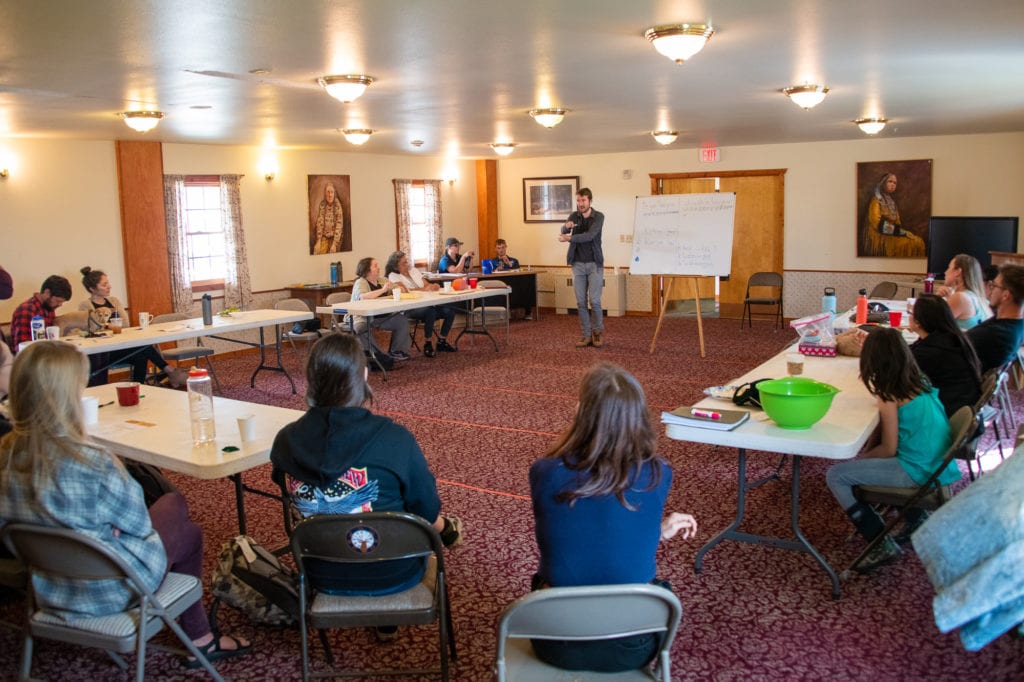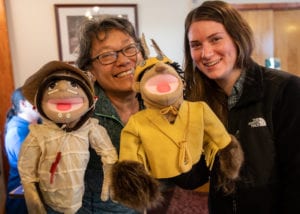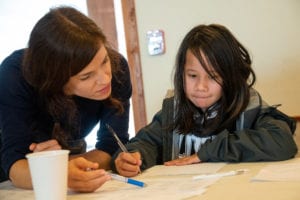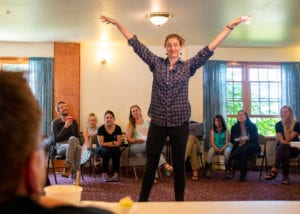
How is an Eyak person expected to learn their own language? A dictionary is available online, but the Eyak language lacks the games and exercises that make self-motivated study manageable. The sixth annual Eyak Culture Camp sought to change that, developing a suite of activities to make language learning not only possible, but fun.
“This year, we spent time thinking about how we could use games to teach, which we hadn’t done before,” volunteer Angela Butler said. “It was kind of a game-changer in thinking about how to teach Eyak.”
The camp, held over the weekend of Aug. 3-4 at the Orca Adventure Lodge, brought together local residents and members of the Eyak diaspora with linguists and archaeologists from across the US, Europe and Australia.
Eyak language lessons were delivered by Guillaume Leduey, a linguist who has spent the past nine years working to revive use of the language. Leduey’s lessons covered the structure of Eyak words and taught attendees basic phrases like, “k’eed iit’eh? k’udzuu xiLeh,” — “How are you? I am well.”

“Language carries so much more than words,” Leduey said. “It carries a whole part of the culture.”
Leduey was the subject of “On the Tip of the Tongue,” a documentary screened at the Cordova Center on Friday, Aug. 2. The film, chronicling Leduey’s study of Eyak, has been shown at festivals in the US and France, and was awarded a jury prize at the Arizona International Film Festival.
“I have never wanted to teach Eyak the way I was taught Latin,” Leduey said. “If some people consider Eyak a dead language, it is not. I don’t even think we should teach Latin or Greek the way we teach it today. It always has to be fun — that’s been my motive for all these years… You learn faster when you play.”
Kathrin Kaiser, a pedagogical experience designer who also attended the camp in 2018, was tasked with developing Eyak language-learning games. Tools for self-motivated learning are vital to reach a community often too thinly dispersed to attend in-person classes, she said.
“There are not many language learning materials available for Eyak,” Kaiser said. “There is an online dictionary… and a dictionary is a good resource, but it doesn’t prompt you or give you feedback.”

Kaiser calibrates her educational games to be challenging but not frustrating, and to link in-game progression to language usage in a natural way. An activity that clumsily inserts educational material into a game framework is like a chocolate-coated carrot, said Kaiser: unlikely to fool anybody.
“Every game teaches you something,” Kaiser said. “But it’s hard to marry these two different goals, of having fun while also picking up a skill that’s not directly related to the mechanism of the game.”
Working with other camp participants, Kaiser designed “Raven says,” a variant on Simon says, and “fishbowl,” a variant on charades. By playing these games in Eyak, players’ success is directly tied to their ability to reference the language. These games were supplemented by more traditional learning methods, like memory games played with cards.
Kaiser and Leduey have also produced an Eyak audio course geared toward independent learning. Educators who attended the camp have gained teaching tools that will be especially useful when working with children, Butler said.

A creative writing exercise helped camp attendees produce Eyak narratives, including what Leduey identified as perhaps the first Eyak poem ever written.
On Sunday, Aug. 4, Ilanka Cultural Center Director Brooke Johnson delivered a presentation on efforts to repatriate Eyak human remains currently held by the Smithsonian Institution’s National Museum of Natural History. In 2017, the Smithsonian Institution returned the remains of 24 Yupik Native Alaskans to the community of Igiugig, where they were reinterred, Smithsonian Magazine reported. If successful, Eyak attempts to reclaim human remains may follow a process similar to the Yupik’s. Pamela Smith, board member for the Eyak Preservation Council, also delivered an update on a project to create an Eyak genealogy display.
The camp was closed out with a potluck at the EPC’s house on the shores of Eyak Lake.
“I hope people have seen how much heart we have and that we’ve come a long way in learning our language,” Butler said. “I hope they’re able to just appreciate the time together as Eyaks, to embrace our culture, to embrace our language and embrace each other.”





